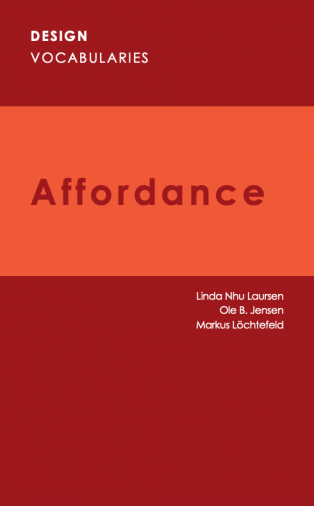Affordance
Contributors
Synopsis
Affordance describes an object or space in terms of the actions made possible for the human in the meeting of a design (or non-design) of anything. Affordance is a key concept across all scales of design, as it allows us to not only understand a site, structure, or object in terms of its physical, aesthetical, and material, properties but how these relate to the abilities of humans or animals and their opportunities for actions. For an object “to be graspable, an object must have opposite surfaces separated by a distance less than the span of the hand.” (Gibson, 1979, p 133). In that way, affordances seek to capture the possible relation, the complementarity of the objects or environments properties and the human’s abilities and intent.
The book is Open Access and can also be purchased via Print-on-Demand from WerkShop's website.
References
Davis, J. L (2020) How Artifacts Afford. The Power of and Politics of Everyday Things, Cam- bridge Mass.: MIT Press
Demirbilek, O. and Sener, B. (2003) Prod- uct design, semantics and emotional response , Ergonomics, 46:13-14, 1346-1360
Djebbara, Z. (ed.) (2022) Affordances in Everyday Life. A Multidisciplinary Collection of Es- says, Cham: Springer
Dokumaci, A. (2023) Activist Affordances. How Disabled People Improvise More Habitable Worlds, Durham: Duke University Press
Gaver WW (1991) Technology affor- dances. In: Proceedings of the SIGCHI confer- ence on human factors in computing systems, New Orleans
Gibson, J. J. (2014, first published 1979). The ecological approach to visual perception: classic edition. Psychology Press.
Gibson, J. J. (1977). The theory of affor- dances. Hilldale, USA, 1(2), 67-82.
Heft, H. (2010) Affordances and the per- ception of landscape, in E. C. W. Thompson, P. Aspinall and S. Bell (eds.) (2010) Innovative ap- proaches to researching landscape and health, London: Routledge, pp. 9-32
Ingold, T. (2011) Being Alive. Essays on Movement, Knowledge, and Description, Lon- don: Routledge
Ingold, T. (2022) Anthropological Affor- dances, in Djebbara, Z. (ed.) (2022) Affordances in Everyday Life. A Multidisciplinary Collection of Essays, Cham: Springer, pp. 51-60
Jensen, O. B. (2023) Mobilities Design. Af- fordances, Atmospheres, Embodiments, in K. Vöckler, P. Eckhardt, M. Knöll & M. Lanzendorf (eds.) (2023) Mobility Design. Shaping Future Mo- bility, Berlin: Jovis Verlag, pp. 24-30
Jensen, O. B., D. B. Lanng & S. Wind (2017) Artefacts, Affordances and the design of mo- bilities, in J. Spinney, S. Reimer & P. Pinch (eds.) (2017) Mobilising Design, London: Routledge, pp. 143-154
Kankaanpää, V., & Hirskyj-Douglas, I. (2023, February). Prototyping with Monkeys: Un- covering What Buttons for Monkeys Look Like. In Proceedings of the Seventeenth International Conference on Tangible, Embedded, and Em- bodied Interaction (pp. 1-13).
Koffka, Kurt (1935), Principles of Gestalt Psychology. New York: Harcourt Brace and Company.
Lanng, D. B. & O. B. Jensen (2022) A Walk in the Park: Affordance as Urban Design Tool for Creating Inhabitable Cities, in Z. Djebbara (ed.) (2022) Affordances in Everyday Life. A Multidisci- plinary Collections on Essays, Cham: Springer, pp. 41-49
Lewin, K. (1917): Kriegslandschaften, in : Grauman, C.F. (Hg.): Kurt Lewin Werkausgabe, Band 4: Feldtheorie, [1983], Huber/Cotta, p. 315-325.
Lombardi, D. (2020) Affordance, in D. Hau- derowicz & K. L Serena (eds.) Age-inclusive pub- lic space, Berlin: Hatje Cantz Verlag GmbH, pp. 189-191
Lopes, P., Jonell, P., & Baudisch, P. (2015, April). Affordance++ allows objects to communicate dynamic use. In Proceedings of the 33rd annual ACM conference on human factors in computing systems (pp. 2515-2524).
Norman D.A. (1988) The psychology of everyday things. Basic Books, New York
Norman, D.A. (1994) Defending Human Attributes in the Age of the Machine [CD-ROM]. Produced and edited by Melanie Goldstein. Irvington, NY: Voyager.
Norman D.A. (1999) Affordance, conven- tions, and design. Interactions 6:38–43
Vermeulen, J., Luyten, K., van den Hoven, E., & Coninx, K. (2013, April). Crossing the bridge over Norman’s Gulf of Execution: revealing feed- forward’s true Identity. In Proceedings of the SIG- CHI Conference on Human Factors in Comput- ing Systems (pp. 1931-1940).
Waltzer, M. (1986) Pleasures and Costs of Urbanity, in Kasinitz, P. (ed.) (1995) Metropolis. Center and Symbol of Our Times, New York: New York University Press, pp. 320-330


